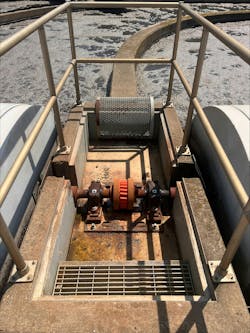Maintaining wastewater systems: Practical tips for upkeep and repair
Key Highlights
- Proactive maintenance reduces emergency repairs, improves safety, and extends equipment life by identifying wear early through inspections and monitoring.
- Proper installation, routine checks, and corrosion prevention are key to avoiding common failures like pump breakdowns and equipment deterioration.
- Emerging technologies such as sensors, IIoT, and predictive software enable real-time monitoring and smarter maintenance planning.
Running a wastewater treatment facility is no easy task. Between aging equipment, rising operating costs and ever-tightening environmental regulations, it often feels like something is always close to failing. And when it does, it never happens at a convenient time.
This is why proactive maintenance and practical repair strategies are more important than ever. Staying ahead of problems, identifying wear before it leads to failure, and using dependable components all help reduce downtime and extend the life of critical equipment.
The value of staying ahead
Identifying and fixing a problem before it breaks is not just smart; it is cost-effective. Preventive maintenance means fewer emergency repairs, better planning and safer working conditions. Regular inspections and tune-ups can keep everything running smoothly, as opposed to waiting for a pump to fail or a valve to burst.
Felice “Phil” Grandinetti, superintendent of a municipal wastewater division in the Midwest, says it plainly.
“If you don’t have a schedule, you’re going to have a shutdown," he said.
His facility relies heavily on checklists, visual inspections and routine part tracking to catch issues before they become emergencies. For Grandinetti's team, consistency is more valuable than complexity.
While his plant does not rely heavily on high-end monitoring systems, many facilities are beginning to integrate sensors and IIoT (industrial internet of things) solutions as part of their preventive strategies. These technologies are increasingly important in keeping major issues at bay, controlling maintenance costs, and ensuring steady day-to-day operations. For example, monitoring temperature changes or vibration levels can alert his team to problems long before the system shuts down.
Whether the method is simple or high-tech, or somewhere in between, paying attention to equipment and maintaining accurate records makes a big difference.
The most common headaches and how to tackle them
Ask any operator about their troubles, and they will say: Pump failures are frequent, seals and bearings wear down, and clogs seem to form overnight. These are not rare occurrences, rather they are part of the job. How much they frustrate depends on how prepared a team is to manage them.
Phil noted that some of the most avoidable failures for him and his team stemmed from simple installation issues.
“You can buy the best part on the market, but if it’s not installed right – if it’s not aligned, torqued properly, or maintained – it won’t last,” he said.
His team now prioritizes proper installation and routine re-checks as part of every service interval.
Corrosion also ranks high on the list of challenges. Whether tanks, digesters or pipes, corrosion is a slow-moving threat that can cost thousands if ignored. Many facilities have found success extending equipment life by using stainless steel, protective coatings, and frequent visual inspections in high-risk areas.
Climate and facility location can also drastically affect corrosion issues. High-humidity marine environments or high-UV desert climates can accelerate wear and deterioration. Material selections, coatings and maintenance schedules are directly impacted by a facility’s environment.
Clogs are another frequent culprit of slowing operations. Particularly in older systems, rags, grease and debris can accumulate quickly. Frequent physical checks and clearings increase the impact of filters and screens.
Smarter tools are changing the game
Technology is starting to play a bigger role in how facilities manage maintenance. Remote vibration sensors, temperature monitors and predictive maintenance software are becoming more accessible and easier to implement across plants of all sizes.
Sensors can monitor everything from pump pressure to motor vibration and will alert users when something is amiss. Some systems go further by employing software to forecast when components are likely to fail based on usage and conditions. Predictive maintenance reduces uncertainty and helps plan repairs for when it's most convenient, rather than during an emergency.
Automation tools are also beginning to handle routine tasks like greasing and flushing lines. This helps crews, especially those that are understaffed, stretch their manpower further and frees up the team to focus on more difficult problems
Product designs are evolving as well. In one facility, a rotating biological contactor (RBC) system was causing constant delays due to traditional bearing failures. After switching to a more service-friendly bearing design with better sealing and simplified maintenance, the plant dramatically reduced unplanned downtime and labor hours.
These innovative tools are not just for large metropolitan systems. Smaller municipal and industrial plants are adopting these technologies too, because they accomplish more with fewer people, reduce long-term costs, and offer real-time insights for faster decisions.
Lessons from the field: Real-world success stories
Whethera in a tourist-heavy coastal town or a midwestern agricultural hub, facilities are seeing results from adopting structured maintenance schedules and smarter repair strategies.
In one coastal city, a treatment plant dealing with seasonal overloads implemented a detailed preventive maintenance schedule for its aeration basin, which holds more than 1.4 million gallons. With increased tourism quadrupling daily demand, the city needed reliable redundancy, and this need was addressed by starting with better planning and infrastructure upgrades. After reassessing their equipment’s condition, the team expanded the system capacity and significantly reduced emergency callouts.
This example highlights how proactive maintenance can go hand in hand with infrastructure improvements. Facilities that invest in modernizing equipment or expanding capacity often find that these upgrades support better performance, lower risk of failure, and greater long-term savings. When preventive efforts are matched with thoughtful infrastructure planning, the results tend to be more sustainable and cost-effective.
In another case, a facility struggling with proprietary equipment delays worked with a technical specialist to identify the issue, source hard-to-find parts, and implement long-term solutions. Instead of spending days sourcing specialty items on their own, they built a support relationship that eventually led to further upgrades and better plant efficiency.
These kinds of incidents are frequent and demonstrate the benefit of being proactive.
An engineer’s perspective: Be the problem-solver
Ted Cotton, P.E., is a professional engineer in the environmental discipline with 30 years of experience as a water equipment supplier. Working with both municipal and industrial treatment plants, he emphasized how regulatory pressure and operational complexity have pushed plants to become more proactive.
“Whether you’re processing food or metal or simply treating discharge, the rules are stricter than ever," Cotton said. "Facilities have to meet them without blowing their budgets.”
Ted described working with processors who needed help navigating complex parts sourcing or equipment replacements.
“In some cases, just being the person who can track down a solution and get it delivered was worth more than being the cheapest," he said. "It’s about solving the problem, not selling the part.”
He believes the future of water system reliability comes down to asking the right questions and building trust.
“A lot of teams are doing everything right," he added. "They just need someone who can step in, help them troubleshoot, and take ownership of the issue until it’s fixed.”
Final thoughts: Get ahead and stay there
Working in wastewater, it is understood that unexpected failures are part of the job. But the frequency and severity of those failures depend on how well one prepares with preventive maintenance.
Stay consistent with inspections. Standardize part usage when possible. Use smart monitoring tools when they are available, and if they are not, track issues manually at the very least. Ensure staff knows what to look for, how to act quickly, and when to escalate an issue before it becomes a crisis. Take it from Grandinetti.
“We can’t afford to wait until something breaks," he said. "That’s not how you run a plant.”
Fewer failures. Fewer surprises. That’s the goal – and it is well within reach.
About the Author

Brandt Brownlee
Brandt Brownlee is an aggregate and wastewater specialist at Motion. He works directly with municipal and industrial facilities, helping them solve problems related to equipment wear, pump and conveyor failures, and other system breakdowns that can disrupt daily operations. Brownlee is especially passionate about developing practical, cost-effective solutions that extend equipment life and reduce downtime. He enjoys connecting with operators, engineers and maintenance teams, translating technical challenges into clear, actionable strategies that can be applied on the ground.
For more information, visit motionind.biz/45ida3H.


